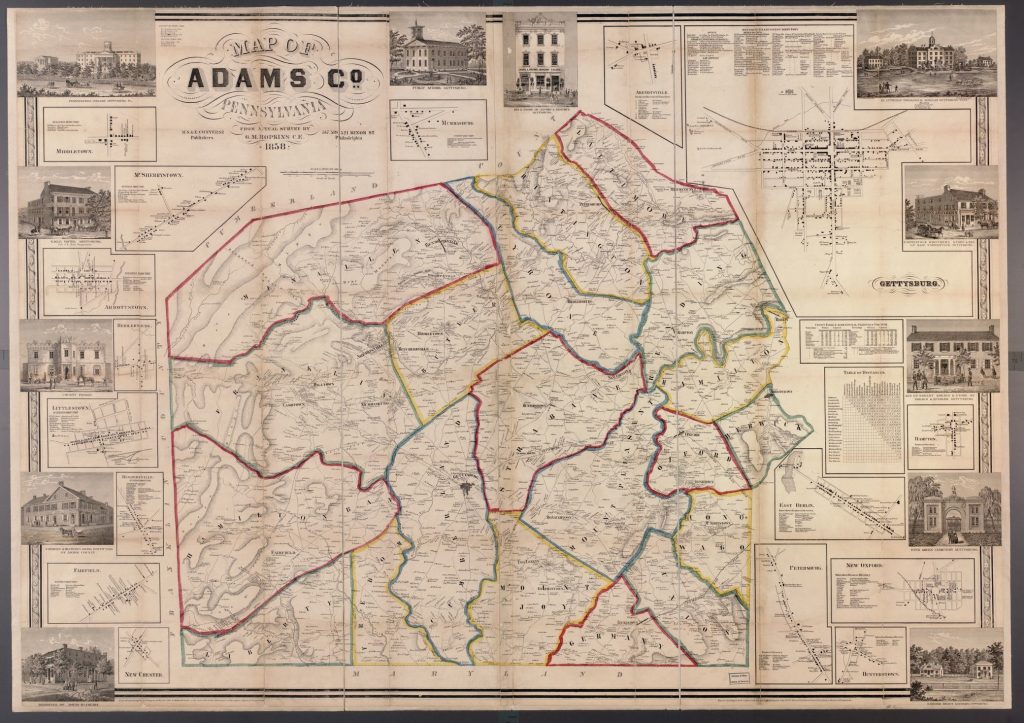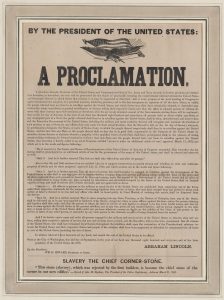Perceptions of Emancipation in Gettysburg, Part One
ECW welcomes back guest author Jon Tracey
Part One of a series

Before the small town of Gettysburg, Pennsylvania was a battlefield, it was simply a small town in south-central Pennsylvania within Adams County. A mere 7.5 miles from the Mason-Dixon Line and slavery in Maryland, inhabitants were well aware of their borderland status. Before immortality in song, story, and memory hard-earned through strife, death, and destruction, they were a normal town like any other. Prior to the Emancipation Proclamation, townspeople debated the merits and risks of abolition. In September 1862, Lincoln’s preliminary Emancipation Proclamation gave them much to talk about, and the town became more divided along political lines than it already was. Before the battle of Gettysburg, Democratic Gettysburg Compiler run by editor Henry J. Stahle fought with the more Republican-leaning Adams Sentinel on the battlefield of public opinion. By examining the debates that the men of Adams County and Gettysburg held about the risks and benefits of emancipation both before and after the battle of Gettysburg, there is much to be learned about perceptions of the Emancipation Proclamation. Though it is lauded today and was supported by some in 1862, many average patriotic Americans held serious misgivings about it during the Civil War.
The 1860 election results show the political divide in the community. Though Republican Abraham Lincoln won the county, his count of 2,724 only barely beat Northern Democrat Stephen Douglas’ 2,644 votes by a thin margin of 80.[1] Lincoln had promised not to interfere with slavery in states where it existed, but there were fears that his election would divide the country. Douglas had run on a position of popular sovereignty, allowing individual states to decide whether to be a slave or free state. In Gettysburg itself, Lincoln received 259 of 484 votes, a thin majority.[2] However, this victory did not mean that Gettysburg was filled with abolitionists. The small difference of supporters indicates many citizens of this border county and small town held strong southern or Democrat sympathies.
Prior to the Proclamation, newspapers reveal the political debates the town engaged in. The divide between Democrats and Republicans was not only close in number as shown by ballots but also very harshly contested. The Gettysburg Compiler was the primary paper, staunchly Democrat, while the Adams Sentinel was a newer paper growing in subscriptions that leaned nearer to Republican beliefs. Though another paper, the Star, favored the Republicans more staunchly, it was published less during the war, held even fewer subscriptions, and eventually merged with the Sentinel.[3] The Compiler and the Sentinel were nearly always at odds, criticizing each other pointedly in most issues. Though the Sentinel leaned towards Republicanism, it was by no means radical. Nevertheless, any leaning was too much for Stahle and the Compiler, who wrote that although the Sentinel claimed they “were no abolitionist,” Stahle asked to know what constituted one as the Sentinel had supported “Fremont’s unconstitutional negro-freeing proclamation in Missouri- Hunter’s in South Carolina- and, subsequently, President Lincoln’s sweeping edict…”[4] Thus, support of Lincoln, especially of the Emancipation Proclamation, seemed enough basis for Democrats to label a neighbor a Republican or even a radical abolitionist.

President Lincoln announced the preliminary Emancipation Proclamation on September 22, 1862. It stated that enslaved peoples that resided in states that were in open rebellion against the government of the United States would become legally free on January 1, 1863. Lincoln deemed it a military necessity that would weaken the ability of the Confederacy to wage war.[5] Immediately, it was subject to criticism by Stahle and other Gettysburg Democrats. Their main argument was that the Proclamation was unconstitutional, and often cited former Supreme Court Justice Benjamin Curtis. “The Emancipation and the martial law proclamations… are in violation of the Constitution,” wrote the Compiler as it reprinted lines from Curtis’ pamphlet, and should they ever be challenged in the Supreme Court, “they will be set aside as unconstitutional, and therefore null and void.”[6] In an attempt to appeal to less legally educated readers, the Compiler also argued that the war was one for Union and Union alone, not emancipation. In highly religious and racialized language, it stated, “Emancipation will bring upon us an influx of negroes to compete with white labor and push on the claim to social and political equity…What say the people of Pennsylvania to a negro immigration into the Commonwealth that will rival in numbers the locusts of Egypt, and make the land as dark?”[7] Democrats such as Stahle supported war for Union, but balked at the thought of emancipation.
In contrast, the Sentinel sought to convince Gettysburgians that the Proclamation was just and necessary. Though it initially shied from the radical ideas of racial equality, it supported the Proclamation as a military necessity. Firing a shot across the Compiler’s bow, it wrote “It is a remarkable fact, that, although every Democratic politician, and newspaper, is satisfied, that the Emancipation Proclamation of the President can be of no practical advantage, yet the Rebel press indicate serious alarm at it, and never mention it but in the most bitter terms, thus showing it to be a most dreaded enemy.”[8] Similarly, the Sentinel had previously printed a letter from a Union officer in charge of transporting prisoners mentioning Confederate dislike of the Proclamation and noted, “The rebels South are very savage on the subject, because they fear it; and the rebels North are denouncing it for the same reason.”[9] This harsh divide between papers’ opposing Democrat and Republican leanings was common in southern Pennsylvania. In Thin Light of Freedom, historian Edward Ayers analyzed Franklin County, Pennsylvania, which is directly to the west of Adams County. There, Ayers noted the Republican Village Record staunchly defended Lincoln, stating the Proclamation “had changed the course of the war and world history.”[10] Yet the dueling Democrat Valley Spirit echoed the words of Gettysburg’s Compiler in thinking that the Proclamation did more harm than good.[11] Despite the presence of Republicans in south-central Pennsylvania, the Democrats still held much social power. This would all change in the coming months.
To be continued…
[1] Charles H. Glatfelter, “Adams County Votes for President, 1804-2008,” Adams County History Vol. 15, Article 3, 27.
[2] Ibid, 58.
[3] Wartime editions of the Star are remarkably uncommon. I was in talks with the Adams County Historical Society for copies to gather their opinion on Emancipation, but the society closed due to Coronavirus. As such, I had no access to it, but through prior readings and context it is highly likely the less popular, more radical paper immediately and staunchly supported the Proclamation.
[4] Gettysburg Compiler, March 9, 1863.
[5] James M. McPherson, Battle Cry of Freedom: The Civil War Era (New York: Oxford University Press, 1988), 557-558.
[6] “Judge Curtis on the Proclamations,” Gettysburg Compiler, November 3, 1862.
[7] “What the Battle is For,” Gettysburg Compiler, October 10, 1862.
[8] The Adams Sentinel, December 2, 1862.
[9] The Adams Sentinel, November 4, 1862.
[10] Edward L. Ayers, The Thin Light of Freedom: The Civil War and Emancipation in the Heart of America (New York, W.W. Norton & Company, 2017), 34.
[11] Ibid, 35-36.
Very interesting piece
If I’m not mistaken, Adams County went Democratic in 1868, voting against Grant for president.
John,
You’re correct. As found in Glatfelter’s “Adams County Votes for President,” here’s the votes:
1868 2917-Grant 3170-Seymour 6087 total
However, as I explore later in this post series, Adams County and Gettysburg did not always have the same political opinion; the town holds a sizable amount of the county population but not all. Plus, Seymour only won by 200 votes of over 6,000, which is awfully close!
After the successful conclusion of the Civil War and the death of the martyr, you would have thought that the victorious general of that war would have won by a landslide. What was even more surprising was the turning of all the former Union loyal slave states, including West Virginia, into the Democratic column by 1876.